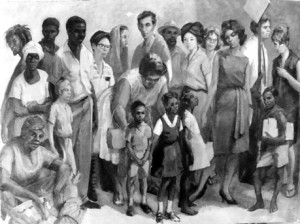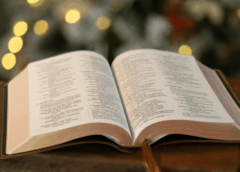Jamaica Master Painter Barrington Watson
Claudia Hucke, Contributor
Courtesy of the National Gallery of Jamaica, we present an essay from the catalogue of ‘Barrington: A Retrospective’, now on show at the National Gallery, the Bank of Jamaica and the Olympia Art Centre through April 29, 2012.
When Barrington Watson returned to Jamaica in 1961, the island was at a historical crossroads. With Independence looming, there was a general optimism in the air and, as Watson remembers, “the island literally went wild” and he himself was determined to contribute to the development of his home country. He recalls, “Everybody was excited and ambitious and thought they found themselves.” Against the background of these nationalist sentiments, Watson expanded the scope of his popular portrait and genre paintings to that of history paintings.

Paintings such as ‘Morant Bay Rebellion’ (1964) and ‘The Hanging of George William Gordon’ (1968) capture a sense of historymaking in the new country. Watson’s history paintings, therefore, need to be seen in the context of the post-Independence process of creating new symbols of national identity that included a national anthem, a coat of arms, a national motto, flower, tree, fruit and bird. In addition, Jamaica created a pantheon of national heroes: Marcus Garvey (1964), Paul Bogle (1969), George William Gordon (1969), Alexander Bustamante (1969), Norman Manley (1969), Sam Sharpe (1975), and Nanny of the Maroons (1976); all of whom played important roles in leading Jamaica from slavery and colonialism to the nationalist movement and into Independence, and all – except for Nanny – feature in Watson’s history or portrait paintings. “I pinpointed events that were very important in the development to Jamaica’s Independence,” Watson said.
Taking into consideration Watson’s training and special admiration of masters such as Sir Joshua Reynolds, Rembrandt, Velazquez and Goya, the choice of history painting is perhaps not surprising. In the 18th century, it was regarded as the highest in the hierarchy of genres over portrait, still life or landscape painting. Traditionally, in addition to historical events, the subject matter of history painting can also be biblical, mythological, allegorical or literary. The British painter and first president of the Royal Academy, Joshua Reynolds, whom Watson had studied while in Europe, even proclaimed history painting “the great style … this universal presiding idea of the art.”
Yet, this citation of a genre of the Old European Masters may seem anachronistic in the context of the 1960s, when much of the international art world lamented the death of painting as an art form, Abstract Expressionism had had its bloom, and radically new styles such as Pop Art and Conceptual Art were on the rise. Students at London’s Royal College of Art (RCA), where Watson was enrolled from 1957-1960, indeed, contributed substantially to the emergence of British Pop Art. The Guyanese Frank Bowling, the American R.B. Kitaj and David Hockney from England, for example, who all entered the RCA in 1959, a year before Watson’s graduation, were among those who revolted against the traditional approaches of their teachers. Watson, on the other hand, remained uninfluenced by these new trends and, in fact, furthered his studies of the old masters on his travels to the European continent, especially in the Netherlands and Spain, where he took classes and sought inspiration on visits to museums.
In chronological order of the historic event, Watson’s history paintings include: ‘The English Landing’ (date unknown), ‘The Morant Bay Rebellion’ (1964), ‘The Hanging of George William Gordon’ (1968), as well as the contemporary history paintings ‘Out of Many One People’ (1962 and c1970),’ The Garden Party’ (1976) and ‘Michael and Fidel’ (1977). In addition, he painted portraits of important political leaders and national heroes: Cudjoe (date unknown), Rt Excellent Sam Sharpe (1976), Rt Excellent Norman Manley (1969) and Sir Alexander Bustamante (1981).
‘The Morant Bay Rebellion’ (1964) is an exercise in traditional history painting in both its formal arrangement and in its use of an event from past history. A well-known episode, today the 1865 uprising is perceived as one of the most eminent events in Jamaica’s history. Twenty-seven years after the abolition of slavery, many of the former slaves were still living under very poor circumstances. Enraged by the unfair trial of a black man, Paul Bogle led several hundred men and women into Morant Bay on October 11, 1865, to protest against the unjust treatment of the island’s black majority.
emotionally detached
Watson’s work captures the moment when rebels storm the Morant Bay courthouse. Slain bodies lie on the ground in front of the courthouse and on the stairs leading to the upper floor. Men in the heat of combat carrying machetes, torches and rifles attack the officials, some of whom are trying to escape into the building, hurriedly running up the steps and through the door on the ground floor. A market woman on the right is screaming in horror.
‘The Morant Bay Rebellion’ is carefully composed, descriptive and emotionally detached as the posture of most of the figures is somewhat strained and both rebels and officials display at times overly dramatic expressions. Watson here employs the heightened emotions and grand gestures of traditional history painting, but chose not to include an image of Paul Bogle in his painting “because, according to my research, he was not at the courthouse on the day of the rebellion. His brother, however, is the man holding the torch.”
Art historian William L. Pressly argues that the purpose of history painting was to “elevate and instruct by showing man at his most heroic.” In order to depict George William Gordon, Watson chose the moment when his dead body was removed from the gallows. Gordon was hanged in Morant Bay on October 23, 1865. Watson’s ‘The Hanging of George William Gordon’ (1968) allows the viewer an intimate position from behind the gallows under the courthouse’s arch. The artist makes us look out into the bright morning sun, our sight only thwarted by the image of two men removing a dead body from the gallows. Reminiscent of Peter Paul Rubens’ atmospheric ‘Landscape with Gallows’ (c1630-1635), the hanged person in Watson’s painting remains indistinct as we only see his back but none of the facial features; we know that it is Gordon only because he is identified in the work’s title.
In the tradition of Christian depictions of the ‘Deposition of Christ’ that often included, among others, the presence of Mary and Mary Magdalene, Watson adds two women and a boy to the scene; all are lowering their heads and covering their faces with their hands. A dog in the foreground is looking up. All the figures’ eyes are covered, averted or blurred; only the dog seems to be looking up at Gordon’s body. The dog, a traditional artistic symbol of loyalty, could imply Gordon’s faithfulness to the cause.
Watson constructs the artistic representation and memory of Gordon’s hanging by making us look back in time. We are not the 1865 audience which would have been positioned outside looking at Gordon from the front. Located in the courthouse and seeing him from behind, we become a contemporary audience who judges the event from a post-Independence perspective. Like the new day alluded to by the rising sun in the painting, the
new nation is born and the death of Gordon becomes a symbol of martyrdom and the nation’s rebirth as a country in which black people attain greater power.
In continuation of his national heroes sequence, Watson painted the ‘Portrait of Sam Sharpe’ (1976), the slave leader of the 1831 Christmas Rebellion. Commissioned by Wycliffe Bennett, Watson’s head-and-shoulders portrait shows the slave leader dressed in a white shirt and brown jacket with a ribbon tie around his neck, an outfit that is associated with his role as a deacon. The face of the then 30-year-old looks mature; the hair is full but a little receding, and he has some wrinkles around the forehead. The eyes that seem to gaze into the distance characterise him as a thoughtful man. Watson’s portrait emphasises Sharpe’s role as deacon and contemplative leader thinking about his actions.
Watson’s contemporary history paintings symbolically capture the spirit of Independence.
According to Watson, ‘Out of Many One People’ shows people at a bus stop, waiting to take the bus into the future. There are many people, young and old, middle-class and working-class, black, white, Indian and Chinese. In the centre of the drawing, a woman protectively leans over a boy and a girl. Around her are other men, women and children. A vendor in the bottom left-hand corner sits over a basket. The diversity of the crowd symbolises Jamaica’s national motto ‘Out of Many, One People’. In this painting, Watson depicted this heterogeneous population on a common journey into the future. As the mother will put her children on the bus first, the new generation, the work implies, will take centre stage in that process.
Contemporary history paintings often include portraits of recognisable people, locations and events of recent memory. All of these are ingredients of ‘The Garden Party’ (1976), Watson’s largest easel painting that he describes as “a celebration of the maturity of Independence.” It was commissioned by the Bank of Jamaica for the opening of their new building on Nethersole Place and forms part of their collection of contemporary art that Watson then assembled.
Measuring three metres by six metres, ‘The Garden Party’ concentrates on the situation in Jamaica during the 1970s, a decade marked by Michael Manley’s democratic socialism. Watson regarded painting as “something like a serious amusement” as it mixes scenes of political relevance with more comical incidents. As a whole, it offers a complex panorama of Jamaican society during that moment in time when the political situation was tense, fear of Communism was widespread, many people fled the island, and yet people went about their everyday business, went to school and played sports.
Symbol of society
The composition is built around a large poinciana tree stretching across the painting’s centre that the artist chose as a symbol of Jamaican society: “The poinciana tree is a very delicate tree,” Watson said. “It is very beautiful when in bloom, but it will break off and fall down even with a strong breeze.” A semi-circular centre formed by the tree’s branches is pulling the composition together; groups of Rastafarians and policemen serve as pillars supporting the activity within and outside. To the far right of the canvas that contains more than a hundred figures, a boxing match is taking place between the political rivals, Prime Minister Michael Manley and Opposition Leader Edward Seaga who had “round after round success in politics.” The audience consists of people belonging to the political establishment of the time, including P.J. Patterson and the contenders’ wives Beverley Manley and Mitsy Seaga. Watson remembers Seaga commenting that he wished he was “more serious about his political statement”. In his later works ‘Roadblock’ (1979) and ‘Manifesto’ (1977), Watson explored the conflict between Manley and Seaga further.
Below the boxing match, in the bottom right-hand corner, a couple, representing the intellectual class, are reading a book with the Communist symbol on the cover. At the same time, a middle-class woman is walking her dog past them as if nothing unusual was taking place. In the right background, behind the boxing match, Watson captures the importance of religion in Jamaican society through a revival meeting, a subject that has been of recurring interest to the artist. Religion, Watson believes, could have acted as a strong force to withstand communism that many feared would be introduced in the country. Possibly for this reason he decided to juxtapose the intellectuals reading Marx with the spiritual scene in the background.
Much larger than the revival scene, Watson presents a Rastafarian group in the foreground. Rastafarianism was gaining more and more influence and acceptance during the 1960s and 1970, and Watson had been interested in the subject from as early as 1962, when he painted the portrait of a Rastafarian. The so-called broom crew, street sweepers, to their right and in the very centre of the painting, represent the government’s attempt to create jobs in a difficult economic climate. They are flanked by market vendors displaying their produce. The police and the soldiers, who frame them, represent discipline and order. Yet, one of the young men is distracted by a semi-nude woman, which allows a criminal to pick pocket a gun and to hold up a couple of tourists. To their left, a man, carrying a small suitcase and a briefcase bearing the Air Jamaica logo, is sneaking away. As one of the ‘panic people’, he embodies the exodus of many middle-class Jamaicans who left the island during what they perceived as a difficult political and economic climate.
In the far left mid-ground, schoolchildren attentively listen to their teacher’s instructions. As in his previous Out of Many One People paintings, Watson emphasises the diverse ethnic backgrounds of Jamaica’s population. There are black, white and Asian children. As a whole, Watson contrasts their youthfulness and their eager learning with the stubborn and heated political reality of the boxing match. In fact, he ironically relates the violence of Seaga’s and Manley’s conflict to two goats fighting in front of a stone wall behind the children. On the same lawn, an artist, strongly resembling Watson himself, is painting a nude model while two boys try to steal a look from behind a plant. “The painter looks like me, but he is really supposed to represent an artist and his presence in society. Nude painting at that time was still quite new and controversial in Jamaica,” Watson explains. Behind a dry stone wall, a relic of the colonial period, men and women are working in the fields. “Because of our history of slavery, most people today would prefer to become doctors and lawyers rather than farmers. But with all the land we have, we could actually feed ourselves,” the artist contemplates.
The very centre of the painting is taken up by a cricket game. Under the expansive branches of the poinciana tree, batsmen and bowlers play peacefully while a group of schoolboys enjoy a game of marbles next to them. Barely visible under the tree’s branches, a group of washer-women sit by a river. Representing a typical motif of Jamaican genre painting, it at the same time directs the viewer’s gaze to the flourishing tropical landscape in the background. Lush green hills lead to a white-sand beach and the deep blue Caribbean Sea.
‘The Garden Party’ took Watson six months to finish. “It was one of the most difficult paintings I have ever done physically. I worked non-stop on it, with very little sleep. It was in my brain the whole time.”
Watson’s history paintings portray those moments in Jamaica’s history that he perceived to be of particular importance in the move towards and beyond Independence. Clearly, Watson regarded Independence as an event of the highest historical significance that could only be honoured by the highest of genres in the tradition of the British Academy, that of history painting. In so doing, Watson was undisturbed by contemporary trends in the international and Jamaican art world, but followed the stylistic conventions of those European masters that he admired.
Author Profile
- ... author, qualified & experienced in journalism, creative writing, editing, the arts, art critique, paralegal, photography, teaching, research, event planning, motivational speaking, workshops for children and adults, visual arts etc. Click here for contact form. ...or email me here
Latest entries
 AdvertorialDecember 27, 2025Legal Wiz Jamaica
AdvertorialDecember 27, 2025Legal Wiz Jamaica General categoryDecember 27, 2025Jamaica postal codes across island
General categoryDecember 27, 2025Jamaica postal codes across island Raw and DirectDecember 25, 20252025 Christmas message with Anthea McGibbon
Raw and DirectDecember 25, 20252025 Christmas message with Anthea McGibbon Raw and DirectDecember 21, 2025Ways to improve Jamaica: 51-60: after Melissa 2025
Raw and DirectDecember 21, 2025Ways to improve Jamaica: 51-60: after Melissa 2025



